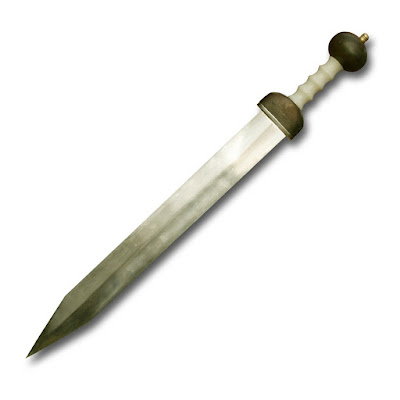Lady Justice has dropped her sword!
The south facing statue of the Roman goddess Iustitia at the Dallas County Courthouse reportedly dropped her metal sword last month after damage to the metal statue's structure caused the weapon to slip from her grasp as reported by the Perry News,(full article).
“The sword on our Lady of Justice on the courthouse actually fell,” said Dallas County Supervisor Mark Hanson, the four-term Republican from Waukee who chaired the board at the time of the fall. “I’m glad someone wasn’t underneath the sword when the sword came down. It came dislodged from up on top. So we have the sword, and the sword is in safekeeping right now.”
 |
| The south-facing lady justice on the Dallas County Courthouse, left, let slip her sword, and it fell to the ground below. No injuries were reported. |
The Roman goddess Iustitia, modernly referred to as Lady Justice is typically depicted as clad in a long roman toga, and holding a sword in one hand, a balance scale in the other, and some depictions have her blindfolded. The symbolism of these elements dates back to imperial Rome, when Iustitia was first introduced to the roman people by emperor Augustus.
The scales are the oldest symbols of justice, having first been depicted in Egyptian religious iconography, where the Goddess Matt would weigh the hearts of the dead against the 'feather of truth'.
The blindfold, which has been used and excluded in various points across history, is intended to show Justice's impartiality. An interesting side note on this is exemplified by the Old Bailey courthouse in London had a depiction of Lady justice without a blindfold, and tourists to the landmark are told that when the statue was made, it was felt that its simple appearance as a women alone would promise accurate justice, rendering a blindfold redundant.
The toga, which is also not universally depicted, is often included deliberately as a nod back to Roman and Greek philosophy, which directly or indirectly influenced many western legal practices and growth over the past 2000 years.
The sword, almost always included with the goddess, is considered the physical embodiment of justice, swift, and permanent.
The sword
As an interesting note about the sword, these weapons are almost always depicted with designs and proportions that are centuries out of character for a 1st century roman goddess.
On the left here, you can see details of photographs from two depictions of Lady Justice, the far from the Castellania in Malta, and the one of the right is from Supreme Court of Queensland, Brisbane, Queensland, Australia.
The image on the left is holding a bell-hilted rapier type blade, a design not even heard of before the late 15th century. And the one of the right, is a long-bladed arming sword with a cross hilt, typical of the 'classic' middle ages, but not widely seen before the 5th or 6th centuries, over 400 years after the Romans first encountered Iustitia.
If someone had asked a roman citizen, or even a small child of the day, to draw a sword, the proportions and shape would almost undoubtedly have been very close to that of the roman gladius . In fact, the word gladius as it was used in 1st century Rome, was synonymous with "sword" and was the backbone of the military, security, and personal guard forces of the empire. While the gladius did come in several very different forms, the overall design of the weapon was still largely uniform when compared to the variety of blades across later history.
Nearly all gladiolus were stout, steel blades that ran between 20 and 27 inches in length and an overall length of up to 50 inches. They were designed to be held and used one-handed, and through could slash well, were predominately built as thrusting weapons for close in fighting. The hilt flared to the width of the blade to keep the user's grip in place, but had no 'wings' to catch downward blows or swipes. Anything outside of this design would likely have been considered foreign, and/or fantastical to roman citizens, detracting from the imagery of the Goddess as the epitome of Roman justice.
The Gladius's broad, clean blade was the epitome of the 'sword' to roman people. That imagery would evolve over time and grown into the Arming, or Knightly sword. With its 28"-31" blade an d much shorter handle and broad hilt that could catch and stop incoming blows, the weapon still only weighed a few ounces (on average) than it roman ancestor.
Nearly a thousand years after the fall of the roman empire, the evolution of the sword would include the rapier, with an ornate bell hilt and ornate guard, these expensive and high end weapons were considered part of the expected attire for gentlemen and nobles in europe during the Renaissance. With a blade that could reach as long as 41 inches in some cases, and with tempered steel much more durable than anything the Romans had produced for combat, the rapier still was considered heavy if it came in much over 2 pounds.
As the sword as evolved over time, so have depictions of the two-millennium old goddess of justice, and so have the justices systems of the world, including many today who invoke her image.
The next time you are in, or near a courthouse, look for a depiction of Lady Justice, and take note and see if the figure is blindfolded, and see what type of sword she is holding.
Kingdom of Ansteorra
"Long Live the King!"


No comments:
Post a Comment